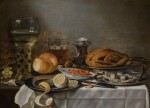
PIETER CLAESZ. | A roemer, tobacco, a chicken, a herring and a partially peeled lemon on a pewter plate, with shrimp in a porcelain bowl, and other fruit, on a partially draped table
Auction Closed
December 5, 12:50 PM GMT
Estimate
30,000 - 50,000 GBP
Lot Details
Description
PIETER CLAESZ.
Berchem 1597/8 - 1660/1 Haarlem
A roemer, tobacco, a chicken, a herring and a partially peeled lemon on a pewter plate, with shrimp in a porcelain bowl, and other fruit, on a partially draped table
monogrammed and dated lower center: PC 164[8?]
oil on oak panel
46.5 x 63.1 cm.; 18¼ x 24⅞ in.
With Galerie Brunner, 1914 (as dated 1648);
J.L. Laverge, Rotterdam;
By whose Executors sold, Amsterdam, Frederik Muller & Cie., 23–30 March 1943, lot 11 (as signed and dated 1642);
With S. Nijstad, The Hague, 1968–73 (as dated 1642);
With P. de Boer, Amsterdam, 1974 (as dated 1642);
From whom acquired.
Delft, Museum Het Prinsenhof, 25e Oude Kunst- en Antiekbeurs, 30 August – 19 September 1973, no. 79.
N.R.A. Vroom, A Modest Message as Intimated by the Painters of the "Monochrome Banketje", Schiedam 1980, p. 28, cat. no. 107, reproduced (as dated 1642);
M. Brunner-Bulst, Pieter Claesz..., Kritischer Œuvrekatalog, Lingen 2004, p. 338, cat. no. 222, reproduced p. 337 (as dated 1656?).
Bearing the hallmarks of Claesz.’s later mature work, the composition of the present picture moves from the simpler arrangements of his earlier œuvre towards the more fashionable pronkstilleven (ornate or sumptuous) still lifes popularised by painters like Jan Davidsz. de Heem (1606–84) and Willem Kalf (1619–93). Though published by Brunner-Bulst as dating to 1656 (see Literature), after careful analysis of the date, this panel seemingly dates to the last years of the preceding decade, despite the last digit of the inscription being somewhat difficult to decipher.
